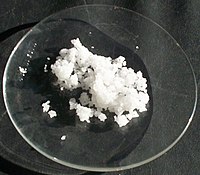
Photo from wikipedia
H2 evolution is the reason for poor reversibility and limited cycle stability with Zn‐metal anodes, and impedes practical application in aqueous zinc‐ion batteries (AZIBs). Here, using a combined gas chromatography… Click to show full abstract
H2 evolution is the reason for poor reversibility and limited cycle stability with Zn‐metal anodes, and impedes practical application in aqueous zinc‐ion batteries (AZIBs). Here, using a combined gas chromatography experiment and computation, it is demonstrated that H2 evolution primarily originates from solvated water, rather than free water without interaction with Zn2+. Using linear sweep voltammetry (LSV) in salt electrolytes, H2 evolution is evidenced to occur at a more negative potential than zinc reduction because of the high overpotential against H2 evolution on Zn metal. The hypothesis is tested and, using a glycine additive to reduce solvated water, it is confirmed that H2 evolution and “parasitic” side reactions are suppressed on the Zn anode. This electrolyte additive is evidenced to suppress H2 evolution, reduce corrosion, and give a uniform Zn deposition in Zn|Zn and Zn|Cu cells. It is demonstrated that Zn|PANI (highly conductive polyaniline) full cells exhibit boosted electrochemical performance in 1 M ZnSO4–3 M glycine electrolyte. It is concluded that this new understanding of electrochemistry of H2 evolution can be used for design of relatively low‐cost and safe AZIBs for practical large‐scale energy storage.
Journal Title: Advanced Materials
Year Published: 2022
Link to full text (if available)
Share on Social Media: Sign Up to like & get
recommendations!